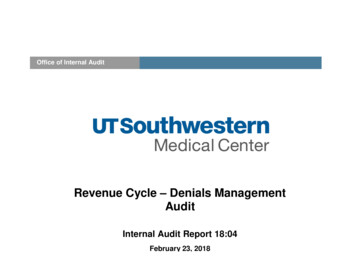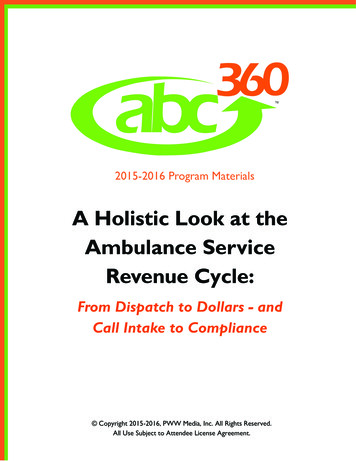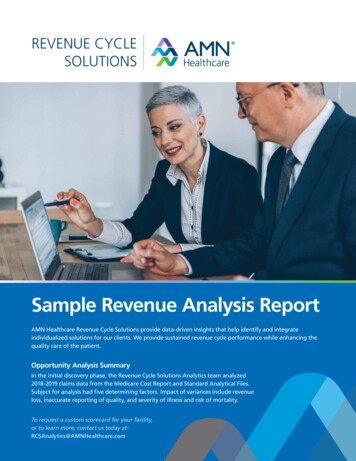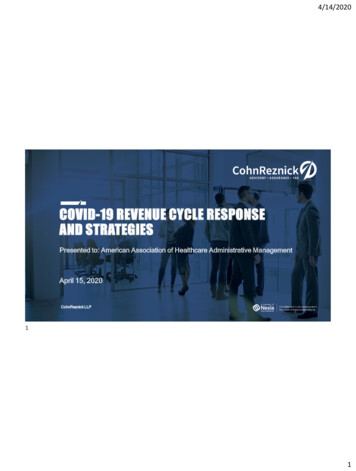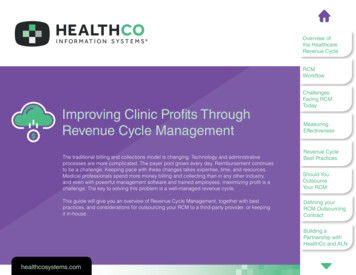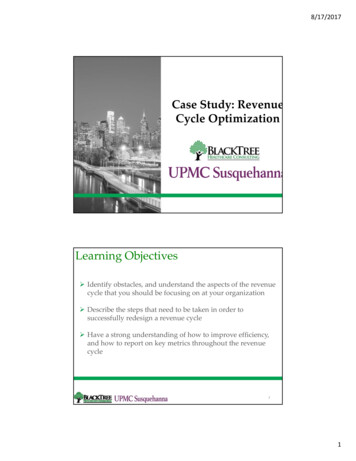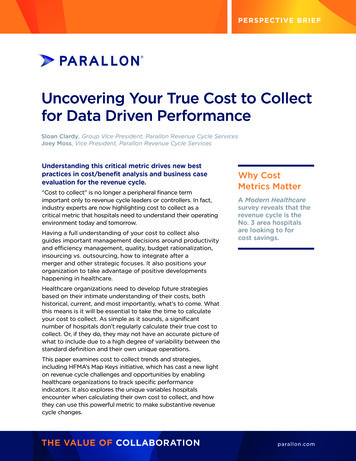
Transcription
PERSPECTIVE BRIEFUncovering Your True Cost to Collectfor Data Driven PerformanceSloan Clardy, Group Vice President, Parallon Revenue Cycle ServicesJoey Moss, Vice President, Parallon Revenue Cycle ServicesUnderstanding this critical metric drives new bestpractices in cost/benefit analysis and business caseevaluation for the revenue cycle.“Cost to collect” is no longer a peripheral finance termimportant only to revenue cycle leaders or controllers. In fact,industry experts are now highlighting cost to collect as acritical metric that hospitals need to understand their operatingenvironment today and tomorrow.Having a full understanding of your cost to collect alsoguides important management decisions around productivityand efficiency management, quality, budget rationalization,insourcing vs. outsourcing, how to integrate after amerger and other strategic focuses. It also positions yourorganization to take advantage of positive developmentshappening in healthcare.Why CostMetrics MatterA Modern Healthcaresurvey reveals that therevenue cycle is theNo. 3 area hospitalsare looking to forcost savings.Healthcare organizations need to develop future strategiesbased on their intimate understanding of their costs, bothhistorical, current, and most importantly, what’s to come. Whatthis means is it will be essential to take the time to calculateyour cost to collect. As simple as it sounds, a significantnumber of hospitals don’t regularly calculate their true cost tocollect. Or, if they do, they may not have an accurate picture ofwhat to include due to a high degree of variability between thestandard definition and their own unique operations.This paper examines cost to collect trends and strategies,including HFMA’s Map Keys initiative, which has cast a new lighton revenue cycle challenges and opportunities by enablinghealthcare organizations to track specific performanceindicators. It also explores the unique variables hospitalsencounter when calculating their own cost to collect, and howthey can use this powerful metric to make substantive revenuecycle changes.THE VALUE OF COLLABORATIONparallon.com
PERSPECTIVE BRIEFTIME FOR ACTIONA recent Parallon pollof 270 healthcareleaders revealedthat close to half ofthe group do nottrack cost tocollect metrics.40% do not currently track their cost to collect.39% use an internally developed definition.13% follow HFMA’s definition for Map Keys.7% work with a consultant or a third party tohelp define cost to collect.HFMA MAP Keys Cost to Collect DefinitionHFMA has made an important move forward in developing a definition for cost to collect. Throughits MAP Keys initiative, HFMA seeks to help healthcare organizations calculate revenue cyclemetrics that define their businesses. Cost to collect is a trending performance indicator thatmeasures efficiency and productivity. HFMA cost to collect definition: “Total” Revenue Cycle Cost divided by “Total Cash Collected.”HFMA provides two options: with and without IT costs. Total costs include: patient access, patient accounting, HIM, outsourcing, benefits, subscriptionfees, software (optional), and “hard” IT (optional). Total cash includes: patient related settlements/payments and bad debt recoveries.Understanding VariabilityWhile HFMA has taken an important step in laying the groundwork for calculating cost to collect,when organizations do a deep dive, variability will inevitably appear in multiple areas. Patientaccess, for example, can cover a variety of things, including pre-access functions, centralizedscheduling, core registration, and admitting functions. When it comes to patient accounting orpatient financial services, there are functions that may or may not be completely clear as to theirinclusion, such as financial counseling, Medicaid eligibility, verification activities, and cashiering.Within the detail of the definition of what organizations may include for patient accounting,however, there is also the option to include CDM maintenance, along with managed carecontracting if it functionally reports up to the revenue cycle.From an IT perspective, soft costs are always included in HFMA’s cost to collect formula. Softcosts are any technology software that is bolted on to the revenue cycle. Hard costs, however,are the optional components, per HFMA. These include servers, other hardware and core systemfunctionality that can and cannot be included. Also, when considering 2014 data submitted toHFMA from participating organizations, there is a significant difference in cost to collect totalswhen it comes to submitting with and without IT costs. For example, at the 50th quartile, theaverage for those organizations submitting cost to collect data without IT are 3.4% of cashcompared to 4.6% of cash when IT is included. This illustrates that there is significant variabilitythroughout the organizations that submit on cost to collect. This is due to true variations in costand the sheer difficulty in accurately measuring cost to collect as well.THE VALUE OF COLLABORATIONparallon.com
PERSPECTIVE BRIEFMoreover, from a denominator perspective, cost to collect istypically expressed as a percentage of cash. While the coredenominator is patient services net revenue, you can includeMedicare pass through payments, Medicare DSH, DME, and GME.However, Medicaid DSH-related, UPL-type program paymentsand other non-patient cash should be excluded.These examples illustrate that cost to collect can be a verydifficult area to analyze.How the Industry Typically Applies Cost to CollectAs organizations interpret HFMA’s definition, they will introducevariability due to their unique structures. While cost to collect isa challenging metric to measure, there are some main areas inwhich organizations share commonalities. Typically, the industryapplies the cost to collect in three areas: Usually Included, OftenIncluded and Sometimes Included. They are as follows:Are YouOverlookingCost Areas?Many times significantcosts impacting thetrue cost to collectdo not reside inthe business officefinancial statements.How to Capture All of Your CostsRegardless of the nuances, the basic goal organizations can agree on is that it is importantto capture the total cost to collect in order to have a well-rounded understanding of yourrevenue cycle.USUALLY INCLUDEDOFTEN INCLUDEDSOMETIMES INCLUDEDPatient accessPre-access financialclearanceFull benefits costsBillingCollections, followup, postingThird party vendorcontract feesRevenue integrityClinicaldocumentationHealth InformationManagement (HIM)Bolt-on softwareTHE VALUE OF COLLABORATIONAdministrativeoverhead costsDepreciationPatient accountingsoftware,IT infrastructureand supportparallon.com
PERSPECTIVE BRIEFPutting together a comprehensive template is a good placeto start. An effective analysis of cost to collect begins witha thorough understanding of the organization’s accountingprocesses and structures. A detailed review will likely revealhidden costs. It is important to involve more than just the revenuecycle management and accounting teams in this evaluation.Departments such as legal, compliance, and those who workin case management should be involved to insure you are notexcluding important items, for example clinical appeals resourcesand legal fees.Traditional factors that influence cost to collect include staffproductivity, staffing mix, labor rates, and vendor costs.Additionally, there are environmental factors that often aren’tconsidered directly in the process, but should be consideredwhen performing comparisons. Those include the size and scaleof the facility or system, the service mix, casemix, the payer mixand the complexities related to payer contracts, among others.Important Costs Often OverlookedOften, significant costs impacting the true cost to collect do notreside in the business office or financial statements. There are fivecategories of costs that are often overlooked when calculatingcost to collect.1. Full cost of employee benefits, including medical benefits,employer paid taxes (FUTA/SUTA), and pension or otherretirement benefits. Many times these are not recorded at theemployee or direct cost center level. One way to address thisis to take benefits as a percentage of salaries for the entireorganization and then allocate that to your revenue cycledepartment. Keep in mind, however, that oftentimes the overallaverage hourly rates or average wage rate for your organizationis likely higher than what is paid to revenue cycle staff.2. Other HR-related costs, including recruiting, severance andretention. For example, some larger organizations with 100 employees may necessitate a dedicated HR generalist. That isan implied and indirect cost that should be captured.3. Certain contract services, such as Medicaid eligibility. It’shighly unlikely that anyone would miss Medicaid eligibility incapturing their cost. Knowing where it is allocated, however,may be trickier. Is it included in patient access or patientaccounting? Industry trends point to a 50/50 split betweenfacilities that record Medicaid eligibility in patient access versusputting it in patient accounting or the business office. Makesure that you have an apples-to-apples comparison.THE VALUE OF COLLABORATIONFactors thatInfluence Costto CollectTRADITIONALFACTORS Staff productivity Staffing mix Labor rates Agency rates Use of technology/automation Vendor/outsourcingstrategyADDITIONALFACTORS Size/scale Service and case mix Payer mix Payer contractcomplexities Functional arearesponsibility Acquisition/affiliationstrategy Different accountingmethodologies Type of informationsystem(s)parallon.com
PERSPECTIVE BRIEF4. Information technology. The most difficult and commonly overlooked items are IT costsand indirect support cost, mainly because these tend to be buried in many different placesin the organization. Organizations often overlook complete systems costs (both capital andoperating); core patient accounting system cost; systems support costs (such as IT departmentcosts); software maintenance and desktop support costs. Such costs can be difficult to breakapart and difficult to understand because only IT administrators may know the answers tothese questions.5. Other operating expenses and opportunity costs: This category includes legal; record retentionand storage; depreciation; training and education; and the opportunity cost of revenuegenerating space. For example, copier leases tend to be an expense that falls into manydifferent places. Also, keep in mind offsite storage, particularly in the HIM space, which can bevery expensive for all those paper records that are decades old.Using Cost to Collect to ManageImportant Business DecisionsHaving a holistic, comprehensive understanding ofyour cost to collect is key not only to managing dayto-day expenses, but also to identifying actionableimprovement areas, driving incremental net revenueyield, prioritizing important projects and defendingyearly budgets. Moreover, this metric will help youmake thoughtful decisions around insourcing versusoutsourcing, whether across the entire revenue cycleor in select areas such as Medicaid eligibility andearly-out collections. Additionally, it is importantwhen it comes to mergers and acquisitions andpost-merger integration. Often such evaluations arenot clear cut. Cost comparisons that are incompletecloud your decision making process, and may serveas the basis for setting unrealistic expectations.Of course, important decisions typically aren’t madeon the basis of cost alone. Well defined businesscases balance the importance of cost to collect withother considerations such as quality, service levelsand future positioning. Looking forward, historicalnotions of cost to collect are being challengedacross the front, middle, and back-end of therevenue cycle. Many providers are reevaluatingorganizational priorities, and in the processconsidering incremental investments in areas suchas compliance, revenue integrity, and customerservice. Cost to collect plays an important role as aforward looking metric.THE VALUE OF COLLABORATIONUsing Cost to Collect toManage the BusinessKey management uses of costto collect Productivity / efficiencymanagement / TQM Budget rationalization Insource vs. outsource decisions M&A/post-merger integrationOther considerations Trend past, present, andprojected future costs. Consider impact beyond cost.Net revenue improvement,compliance, and customerserviceparallon.com
PERSPECTIVE BRIEFThe Bottom LineThe bottom line is the demands on the revenue cycle arechanging fast, which is why it is essential to embed cost tocollect analysis into all processes. In the future, organizations willneed to redeploy current resources, utilize new technologies,leverage shared services and more. In order to accomplish thesegoals, they need to have an accurate understanding of costto collect. Not only that, the value in knowing your true costto collect also impacts day-to-day productivity and efficiencymanagement. A successful cost-to-collect strategy beginswith applying a standard definition followed by a thoroughexamination of your organization’s unique accounting processand profile.Highperforminghospitalsutilize cost tocollect to drivetheir organizationsforward.About the AuthorsSloan Clardy has more than 18 years of experience assisting many of the industry’s top100 hospitals and healthcare delivery systems improve financial performance.Joey Moss has a proven track record of shared services strategy and operations acrossthe entire revenue cycle, working with clients to improve overall performance anddrive process efficiency.Parallon strives to provide accurate, up-to-date information, but our materials should not be deemed as legal advice or counsel butrather as supplemental material offered as an informational component to Parallon’s services. 2015 Parallon Business Solutions, LLC. All rights reserved. SB 150818THE VALUE OF COLLABORATIONparallon.com
its MAP Keys initiative, HFMA seeks to help healthcare organizations calculate revenue cycle metrics that define their businesses. Cost to collect is a trending performance indicator that measures efficiency and productivity. HFMA cost to collect definition: "Total" Revenue Cycle Cost divided by "Total Cash Collected."

